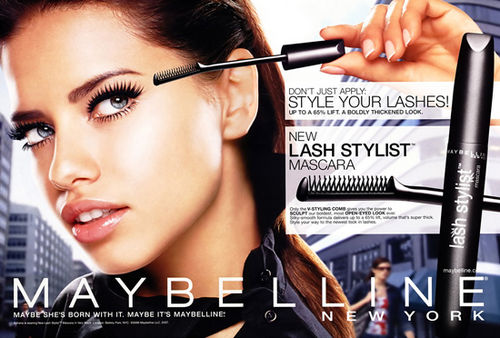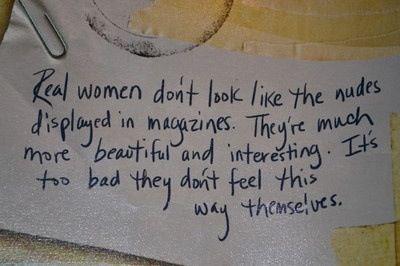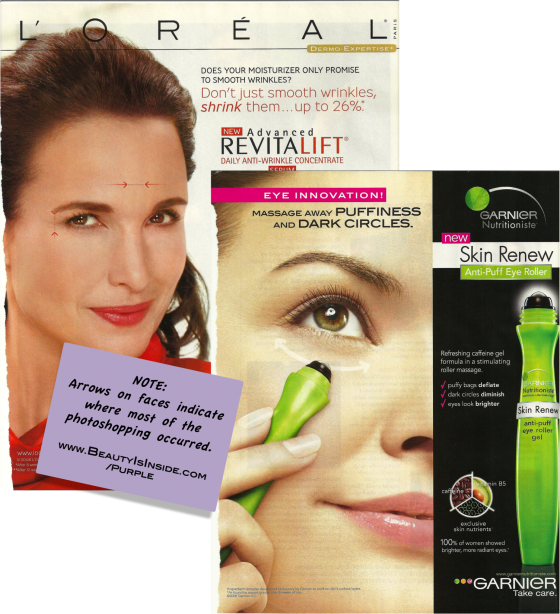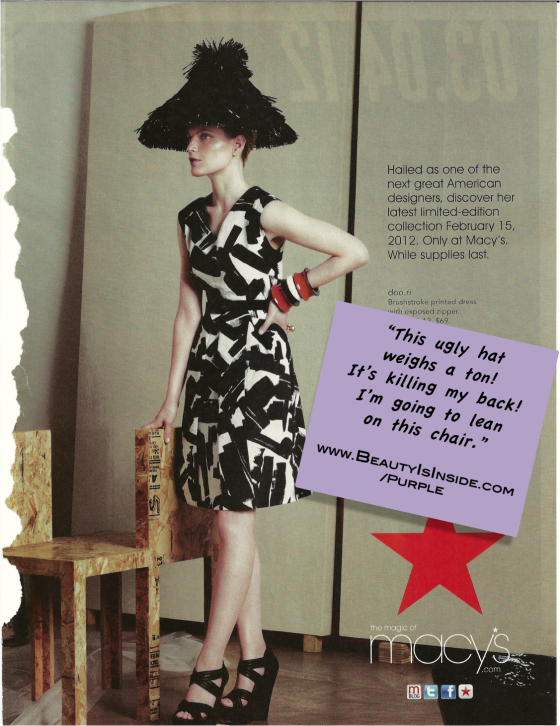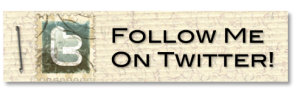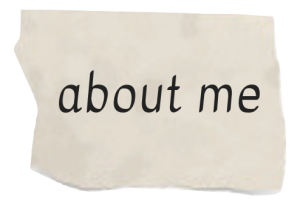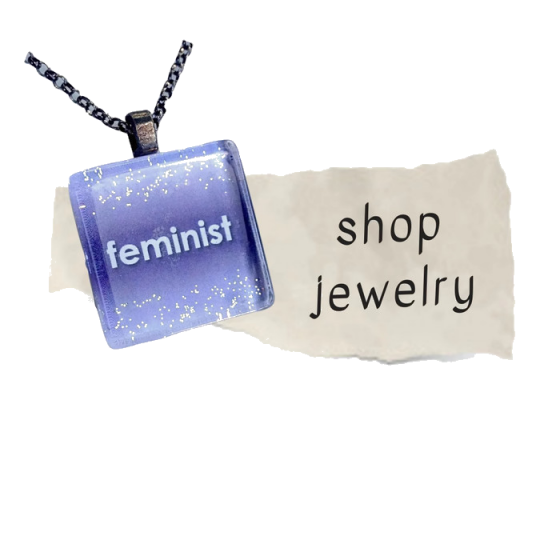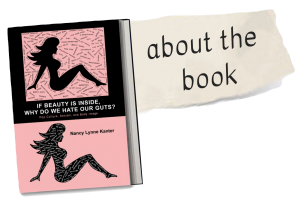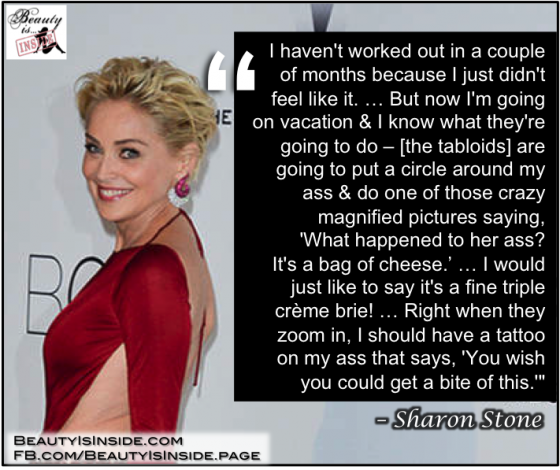
Posts in category Magazines
If Men Posed Like Women Do
The media's treatment of women as sex objects is a ubiquitous fact of life. Advertisements, fashion spreads, comic books, movie posters -- nearly everywhere you look, women are shown in various stages of undress and posed in positions that make them look vulnerable, submissive, and sexually available. Conversely, men are depicted in positions of power or dominance, e.g., standing while a woman is reclining, being fully clothed while she's undressed, etc. These differences reinforce inequality between the sexes. Really, how powerful can a woman feel when she's half-naked and awkwardly contorted?
It's an interesting social experiment to see what happens when men are placed in these typical "female" poses.
The image below features two Vanity Fair covers: the top one with fully-clothed fashion designer Tom Ford, along with a nude Keira Knightley and Scarlett Johansson; and the bottom one is a Vanity Fair spoof of their own cover with a fully-clothed Paul Rudd and a pretend-nude Seth Rogen, Jonah Hill, and Jason Segel. In a separate issue, Vanity Fair also did a photo spread with comedians Kristen Wiig, Maya Rudolph, and Tina Fey, but posed them as typical sex objects. As Entertainment Weekly asks, would it be "... just as uproarious if some of those ladies vamped ironically in body stockings[?] ... Men being objectified is so silly as to be hilarious, but it’s better if funny women are also hot."
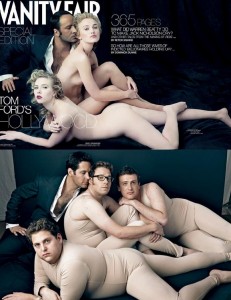
Here's a similar set of images showing nude female models huddled together and then one with the guys from the "Jackass" TV series and movies: 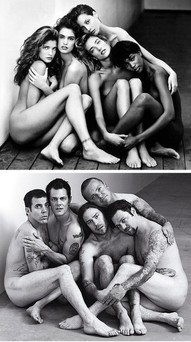
The following "men-ups" were created by photographer Rion Sabean to parody classic pin-up poses. According to Rion, his work focuses on "... gender and sexuality, wherein I attempt to bring light to the scrutiny and judgments of a society that defines human beings under rigid, antiquated terms."
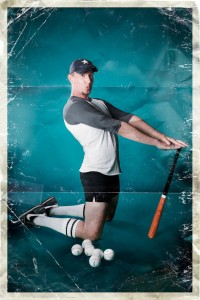

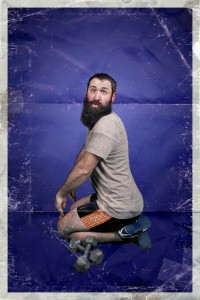
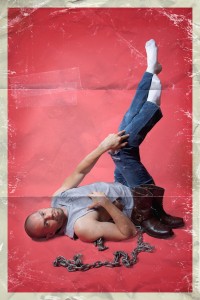
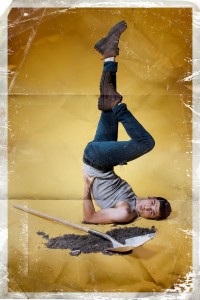

Artist Paul Richmond created a similar series from a gay male perspective. "I began the Cheesecake Boys series to rectify the inequalities in the underwear-flashing art genre known as pin-up," said Richmond.
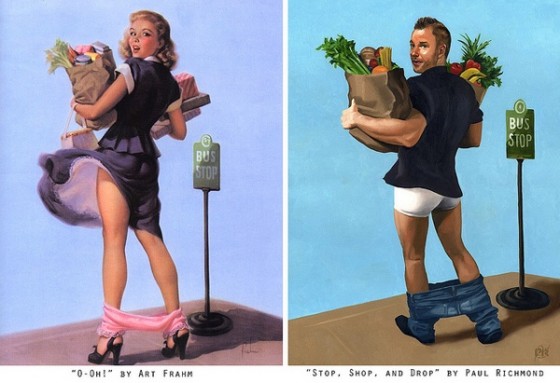
Here's Richmond explaining how he came up with the concept, along with more examples of his work:
Fantasy author Jim Hines parodied women's poses on the covers of fantasy novels by trying to replicate the poses himself. (He also did a series posing like the men on romance novel covers). "... [M]ost of these covers are supposed to convey strong, sexy heroines, but these are not poses that suggest strength. You can’t fight from these stances. I could barely even walk," said Hines.
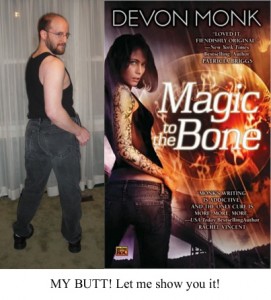
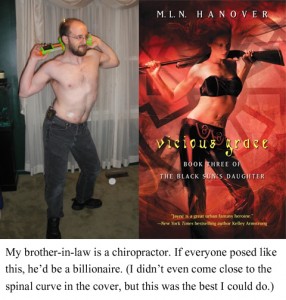
Supermodels from 1994
Kathy Ireland, Elle MacPherson, and Rachel Hunter (L-R) appeared on the cover of the Sports Illustrated Swimsuit Issue in 1994. Today's thin ideal, popularity of plastic surgery, and extreme Photoshopping make 1994 seem like such a long time ago. And times have certainly changed.
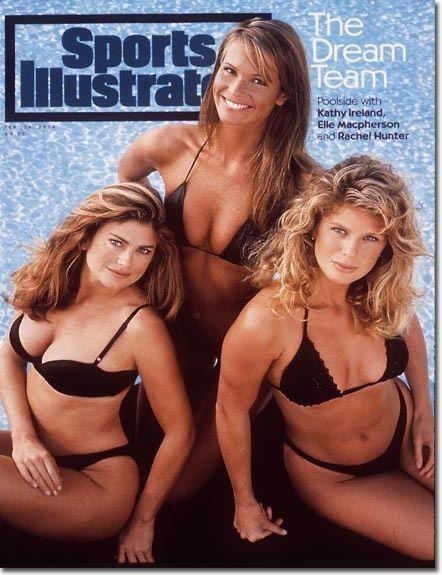
“Perfect”
We see photos like this all the time in the media. Many of us compare our "flawed" bodies with the model's seemingly "perfect" one, & then feel like crap. But here's a reality check that shows how this model morphed into "perfect":
1) nose narrowed
2) breasts enlarged & brought closer together
3) protruding ribs removed
4) waist narrowed
5) belly pooch flattened
6) skintone lightened & smoothed out
7) hips made curvier
8) inner thighs slimmed
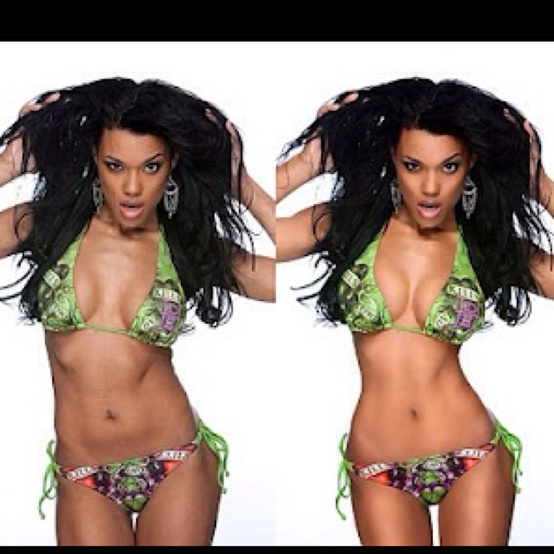
Not Very Gentlemanly, GQ
Can you spot the difference between these three photos? One of the things that indicates sexism is when women are treated in a way that reduces them to a superficial quality, such as treating women as sex objects. In these photos, "Ben Affleck and Channing Tatum sharing the 'man of the year' title and Rhianna [is] named 'obsession of the year.' Affleck and Tatum are fully dressed, while Rhianna just gets a leather jacket. Affleck and Tatum get closeups, while Rhianna gets a suggestive body shot."
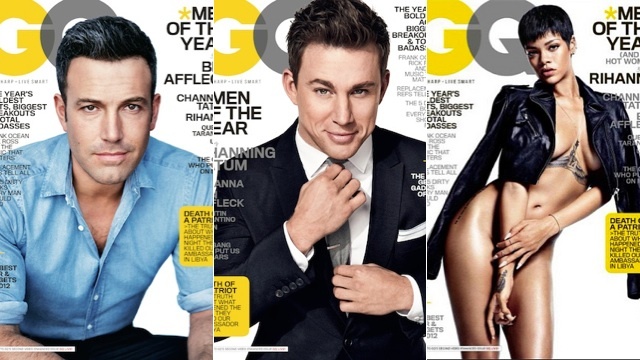
Why am I getting deja vu? Oh yeah, it's because of the recent British GQ's Men of the Year covers, which featured fully-clothed comedian/Broadway star James Corden, fully-clothed singer Robbie Williams, fully-clothed rapper Tinie Tempah, fully-clothed "Mad Men" star John Slattery, and naked singer/Internet celebrity Lana Del Rey.

I'm noticing a trend here. Apparently, GQ doesn't think women are noteworthy unless they're undressed. You'd think that a magazine called Gentleman's Quarterly would behave in a more gentlemanly manner. But no.
Model Thin
Apparently, you can be too thin in the fashion world, but it isn't a matter of health. It has more to do with the aesthetics of showing lots of skin with a tad too much rib.
"[The magazine] Numéro, it seems, liked that [top model Karlie] Kloss was so thin but hated that her thinness made her bones more apparent. So in a have-your-cake kind of gesture, it made the bones disappear with Photoshop. ... We've become conditioned to expect perfected images of skinny, apparently boneless, smooth little girls in our magazines. In a certain way, we've come to rely on Photoshop to insulate us from the sharp reality of what maintaining an industry-approved fighting weight can do to a human body."
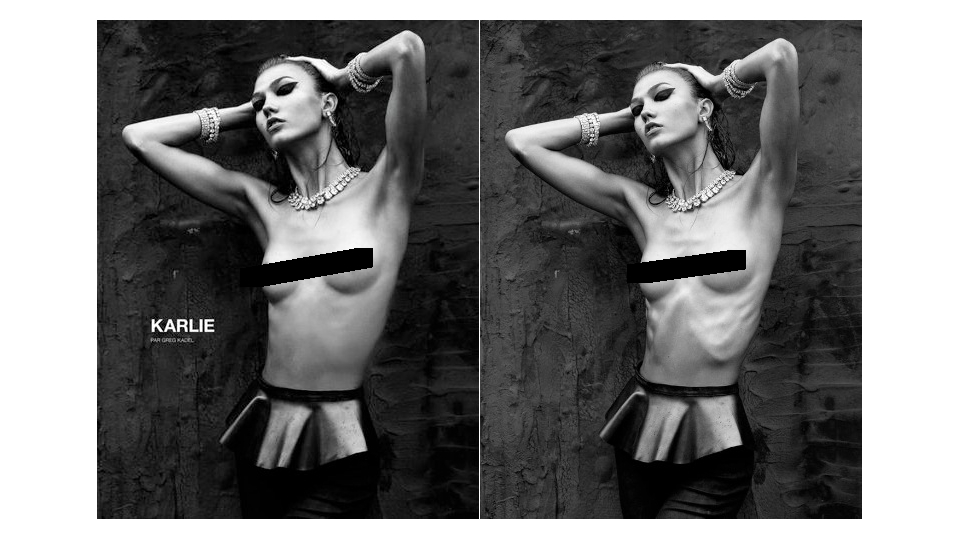
If Men Posed Like Women …
The media's treatment of women as sex objects is a ubiquitous fact of life. Advertisements, fashion spreads, comic books, movie posters -- nearly everywhere you look, women are shown in various stages of undress and posed in positions that make them look vulnerable, submissive, and sexually available. Conversely, men are depicted in positions of power or dominance, e.g., standing while a woman is reclining, being fully clothed while she's undressed, etc. These differences reinforce inequality between the sexes. Really, how powerful can a woman feel when she's half-naked and awkwardly contorted?
It's an interesting social experiment to see what happens when men are placed in these typical "female" poses.
The image below features two Vanity Fair covers: the top one with fully-clothed fashion designer Tom Ford, along with a nude Keira Knightley and Scarlett Johansson; and the bottom one is a Vanity Fair spoof of their own cover with a fully-clothed Paul Rudd and a pretend-nude Seth Rogen, Jonah Hill, and Jason Segel. In a separate issue, Vanity Fair also did a photo spread with comedians Kristen Wiig, Maya Rudolph, and Tina Fey, but posed them as typical sex objects. As Entertainment Weekly asks, would it be "... just as uproarious if some of those ladies vamped ironically in body stockings[?] ... Men being objectified is so silly as to be hilarious, but it’s better if funny women are also hot."

Here's a similar set of images showing nude female models huddled together and then one with the guys from the "Jackass" TV series and movies: 
The following "men-ups" were created by photographer Rion Sabean to parody classic pin-up poses. According to Rion, his work focuses on "... gender and sexuality, wherein I attempt to bring light to the scrutiny and judgments of a society that defines human beings under rigid, antiquated terms."






Artist Paul Richmond created a similar series from a gay male perspective. "I began the Cheesecake Boys series to rectify the inequalities in the underwear-flashing art genre known as pin-up," said Richmond.

Here's Richmond explaining how he came up with the concept, along with more examples of his work:
Fantasy author Jim Hines parodied women's poses on the covers of fantasy novels by trying to replicate the poses himself. (He also did a series posing like the men on romance novel covers). "... [M]ost of these covers are supposed to convey strong, sexy heroines, but these are not poses that suggest strength. You can’t fight from these stances. I could barely even walk," said Hines.


A Woman’s Declaration of Independence
The following is an excerpt from the upcoming book -- If Beauty Is inside, Why Do We Hate Our Guts?: Pop Culture, Sexism, & Body Image. Read the first chapter here.
It's time to declare independence, to separate ourselves from the bad habits, the stifling expectations, and the negative messages that no longer serve us (assuming they ever did).
It's time to declare independence from media messages that tell us we're ugly if we don't look like the "flawless" images of celebrities on the screen and in the magazines. It's time to stop buying into the manipulation and stop wasting time trying to chase an illusion that doesn't even exist.
It's time to declare independence from the belief that having the perfect body will make us worthy of love and respect. We're already worthy of love and respect in the bodies we have now -- no amount of weight loss or plastic surgery will increase our value.
It's time to declare independence from dieting, from deprivation, from seeing food as the enemy. The American weight loss industry makes nearly $60 billion a year trying to convince us that we're not good enough -- if diets worked, would they be this profitable? It's time to stop contributing to their false sense of hope.
It's time to declare independence from body loathing, from looking at our bodies with disgust instead of love. It's time to appreciate all of the amazing things they do for us -- the jiggly arms that give great hugs, the flabby thighs that carry us through the park, the droopy breasts that fed a child, the wounded heart that still knows how to love, the exhausted brain that still manages to tell our lungs to breathe.
It's time to declare independence from spending so much time, energy, and money trying to fit into someone else's idea of whom we should be. It's time to put ourselves first, to focus on our own desires and do what we want instead of what's expected of us. It's time to trust our instincts and become someone we're proud of.
It's time to declare independence from shame, from the belief that we're not good enough, not beautiful enough, not thin enough, not smart enough, not clever enough, not sexy enough. It's time to declare that we are already enough -- that we are perfectly imperfect exactly as we are.
It's time to declare independence from the oppressive labels of virgin or whore, straight or gay. Our sexuality does not define us. It can't possibly define what kind of person we are or what's in our hearts or our minds. Any attempt by others to claim otherwise is an attempt to control us, to police our behavior, and to shame us so that they don't have to examine their own ignorance and fear.
It's time to declare independence from the belief that we can bring sexual assault upon ourselves based on how provocatively we're dressed, how flirty we act, or how drunk we get. The only person responsible for a rapist's behavior is the rapist himself. We have a right to feel safe in the world.
It's time to declare independence from legislators who think the female body should be controlled by wealthy, middle-aged, white, conservative men. Our bodies belong to us -- it's time to declare our freedom to make our own decisions about them. Because if we cannot, then we are truly not equal citizens and this country as not as free it claims to be.
It's time to declare our independence from any force that tries to hold us down -- especially those forces that limit us from within.
Courage to be Real Campaign
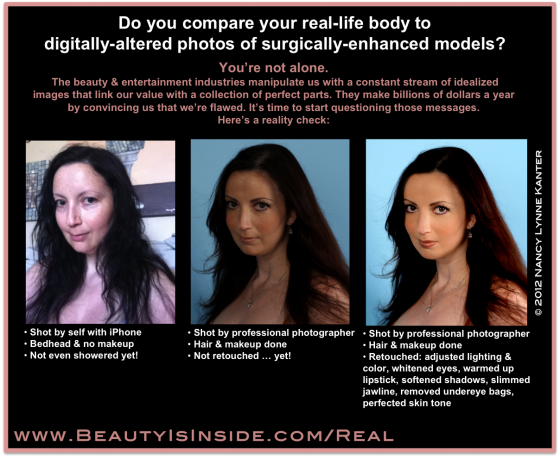
This is me. Don't think for one second that posting a picture of myself with dirty hair, no makeup, and in unflattering lighting didn't take some ovaries! Like many women, I've struggled with not feeling pretty enough, thin enough, perfect enough. I'll be the first to admit that I think I look the best in the photo on the right. It's the photo I use on the back of my book and on the About Me page of this website. I am definitely a product of our beauty-obsessed culture. But this is also me sacrificing my vanity for the greater good. How can I talk about body acceptance and the need to fight against sexist and oppressive imagery if I'm not being real with myself? It takes courage to be real. So everyone, this is what I look like in the morning. Deal with it.
The media manufacture female insecurity for profit. They invent flaws in our appearance and pressure us to fix them. They segment the female body as if it were a bucket of chicken -- we're just legs and breasts and thighs. They convince us that our bodies are too meaty and fatty, our skin is too greasy, and our hair is too fried. They manipulate us with idealized images of hot chicks who were perfected by plastic surgeons, injectable facial fillers and paralyzers, professional photographers, makeup artists, special lighting, hair stylists, fashion designers, and finally photoshopping. And then we compare our real selves with this illusion. It's not a fair fight.
A woman's appearance is always treated as relevant. Tabloids critique female celebrities for gaining weight or having the "worst beach body". The Playmate of the Year is featured on the evening news. Political commentators assess female candidates' appearance almost as much as their political beliefs. We're trained to think that our sexuality is our primary source of power. I discuss this in my upcoming book, If Beauty Is Inside, Why Do We Hate Our Guts?: Pop Culture, Sexism, & Power. In the recent documentary Miss Representation, the filmmaker also examines how our culture's sexualization of women actually minimizes our power in society. Just think about it -- if the most powerful women in the country are reduced to their looks, how can any of us expect to be treated with respect?
It starts with respecting ourselves and having the courage to be real. We have to stop allowing the media to define us in such a superficial and demeaning way. When we pull back the curtain, we see that the sculpted and perfected illusion is just a real woman who has more in common with us than we think.
I wasn't exactly excited to share my naked face with the Internet, but I put together the above image so that you could see the reality behind the special effects. I'd love to see models and celebrities do the same, but their careers depend on them maintaining the illusion. So for now, maybe it'll just be up to us regular women. And that brings us to Beauty Is Inside's new "Courage to be Real" Campaign!
The "Courage to be Real" Campaign is about cracking the illusion of perfection that makes us hate our bodies and compete with each other. I challenge you to be courageous and send in "before and after" photos of yourselves, along with what was manipulated in the "after" photo. Send your photos to real@beautyisinside.com. I'll collect them all in a photo gallery on this site, and I'll also post them on the Beauty Is Inside Facebook page and on Twitter @_BeautyIsInside.
Come on -- if I did it, so can you! Together, we can inspire other women and girls to have the courage to be real themselves.
Some Bunny Stinks
The Playboy bunny logo has become a part of pop cultural imagery and can be found on hundreds of products, e.g., jewelry, handbags, t-shirts, and bedding. These products aren't just trashy and tacky, but they're subtle examples of how pornography has gone mainstream.
Below is a little something for the guys to remind them that wherever they're from, they can always smell like a dirty old man in a smoking jacket.
Introducing Eau de Douchebag, by Playboy.
 It's a little hard to read, but this collection includes the following four colognes:
It's a little hard to read, but this collection includes the following four colognes:
Miami Playboy -- Inspired by Palm Beach retirees in unbuttoned Tommy Bahama shirts exposing grey hairy chests and gold chains. Has a hint of coconut and Viagra.
Hollywood Playboy -- Inspired by short, balding, beady-eyed sleazebags who prowl Sunset Blvd. and try to get laid by name-dropping and claiming that they're producers. Has a shallow and superficial scent.
Vegas Playboy -- Inspired by married engineering conference attendees who high-five their buddies while getting lap dances and shouting "Vegas baby!" and "What happens in Vegas stays in Vegas!" Has a slight fragrance of stripper sweat and glitter.
Malibu Playboy -- Inspired by homeless 45-year-old surfers who reminisce about their high school glory days and call everyone dude and brah. Has an underlying whiff of rotting seaweed and ocean at low-tide.
Beauty Magazines Make Us Feel Ugly
In a recent study, researchers found that 100% of women felt bad about their appearance after looking at beauty magazines for just a few minutes. From one of the authors: “Surprisingly, we found that weight was not a factor. Viewing these pictures was just bad for everyone,” said Laurie Mintz, associate professor of education, school and counseling psychology in the MU College of Education. “It had been thought that women who are heavier feel worse than a thinner woman after viewing pictures of the thin ideal in the mass media. The study results do not support that theory."
I happened upon this brilliant way of fighting back. This was part of a campaign by the National Eating Disorder Information Centre (NEDIC) in Canada that targeted beauty magazines. From NEDIC's website: "To involve the public in our campaign, this transit shelter ad appeals to dieters and those who feel the pressure to diet (virtually all women), empowering them with a way to really shed their weight problem."
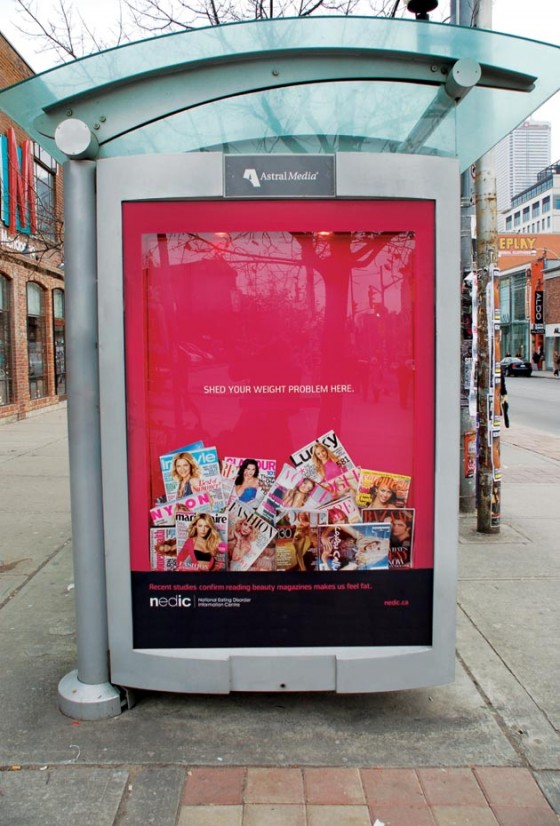
Close-up:

Text at bottom of display:
"Recent studies confirm reading beauty magazines makes us feel fat."
Another study demonstrated "... the role of the media in shaping, rather than merely reflecting, societal perceptions of the female body. Consistent with our hypothesis, it was found that women's body image satisfaction is, indeed, influenced by their exposure to the thin ideal presented in fashion magazines."
(Want more? Here's one of my previous posts on this topic.)
Strike a Pose
June's issue of Vogue Italia (NSFW due to some nudity) offered a refreshing break from the typical images of female perfection plastered over every fashion and beauty magazine. This issue, entitled Belle Vere or "True Beauty," featured "plus-size" models both on the cover and in a photo spread. As is the case in the media, plus-size means average-size in real life. I don't know the statistics in Italy, but the average American woman is 5’4” and weighs 165 pounds. A woman this size would most certainly be plus-size in the modeling world, and it would be quite uncommon for a magazine to have her gracing its cover, at least in the United States.
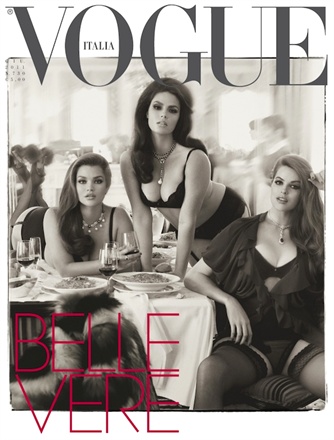

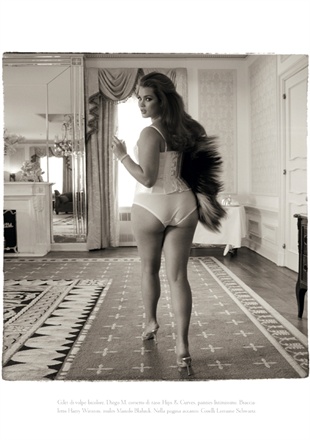
We don't get to see many images in the media that resemble what most of us look like, unless they're "before" photos. Although the women in this issue of Vogue don't fit the media ideal in terms of body size, they still look beautiful and glamorous, because they had the same model treatment that the typical cover girls get.
Even the women who are typically on the covers of magazines don’t jump out of bed looking as flawless as they seem to be in the photos. Why should we hold ourselves to a higher standard? We’re so used to comparing our real-life mirror images with the media ideal. But it’s not a fair fight. Those images were created with the help of hair stylists, makeup artists, fashion stylists, good lighting, designer backgrounds, professional photographers, and photo retouchers. We can get a similar effect if we use the same tricks they use, regardless of our weight or whether we have personal trainers, chefs, or plastic surgery.
Here’s an experiment: go to a salon and get your hair and makeup done. Dress up in beautiful clothes that fit and flatter (take advantage of supportive undergarments that lift things up and suck things in). Next, get professional headshots taken or ask an amateur photographer friend to snap photos of you. Take hundreds of pictures in lighting that glows and in poses that flatter. Out of the hundreds of photos, choose the few that capture you at your best. Then, have those photos retouched.
This is a chance to see yourself in that same idealized light that you’re used to seeing other women. It's a good reminder that we don’t have to be perfect to be pleased with our reflections -- we can all look flawless given the right tools.
Newsstand by Me
What should a woman’s day consist of? More importantly, what is a woman’s true essence? According to magazines, we should aim for glamour and allure, as these are what will offer us the most value in life. Psychology today tries to put us in touch with the self. It tells us that we’re wired to look to our parents and our family circles for details about navigating the world, or simply our town and country. They teach us that being a woman requires us to look pretty and have good housekeeping skills. If our mothers jones for cellulite prevention and physical perfection, chances are that we will too. They ready us for the beauty and fashion magazines to reinforce this notion by taking over as both car and driver. They make our vanity fair game.
Magazines offer highlights into how our lives can be lucky as long as we take the right road and track. To them, this means being in style, in vogue, much like a cosmopolitan New Yorker would be. It means being in shape like Ms. Muscle and Fitness and perpetually seventeen years old. It means being a sassy mademoiselle. It means being thin and beautiful enough to deserve a playboy* who will offer us food and wine, travel and leisure, better homes and gardens, and the big O in his penthouse* – maybe even turn us into brides. This is supposedly the dream written about in each Saturday evening post in any ladies’ home journal and every wish upon a star.
But it’s all a mirage. Magazines waste so much of our time with mindless entertainment weekly, monthly, and daily. The popular science of marketing ensures they make smart money with the advertising age, striving for consumer reports that signify people are letting the ads in magazines and TV guide them in their purchases. And we readers digest it all.
The maxim* that you can’t believe everything you see is true. It’s real simple – magazines offer spin. From across the nation, from the Atlantic to the Pacific, there are thousands of women who are mad about the endless pressure to look perfect. We need to stand up and bitch, to say it’s not OK, because seriously, the stuff* we put up with is just bazaar.
(* Don't worry -- these link to Wikipedia pages, so they're SFW.)
Help Hugh Know Who
It appears that just a paltry pack of pervs are still peeping at porn printed in paper pictorials. Is poor Playboy's popularity perhaps ... petering out? What a pity.
Fortunately, an unlikely heroine is taking up the cause! In response to the company's financial difficulties, The Daily Show's Kristen Schaal offers an appeal for donations to the Save the Mansion Fund. As she sweetly says: "Living, breathing women with hopes and dreams are standing by to take your pledge."
| The Daily Show With Jon Stewart | Mon - Thurs 11p / 10c | |||
| Save the Playboy Mansion Fund | ||||
|
||||
Maybe She’s Born with It …
 Maybe it's photoshopp--ing.
Maybe it's photoshopp--ing. 
